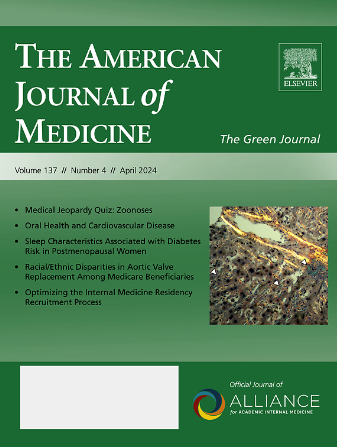2021 年 COVID-19 大流行期间非老年成人的司法介入状况和住院死亡率。
IF 2.5
3区 医学
Q1 MEDICINE, GENERAL & INTERNAL
引用次数: 0
摘要
目的:研究在 COVID-19 大流行的第二年,司法介入状况对非老年成人住院死亡率的影响:这项回顾性队列研究使用的数据来自美国 20 个州的 2021 年州住院病人数据库 (SID),其中包括住院至少 24 小时的 18-64 岁成年人从普通急症医院出院的情况。主要结果是全因住院死亡率,主要比较是司法介入状态。我们使用逻辑回归法估算了几率比(ORs)和 95% 置信区间(CIs),并对社会人口学因素、Elixhauser 合并症、COVID-19 诊断、入院敏锐度、其他临床特征、都市地区和季节性进行了调整。我们将数据随机分成 50% 的训练集和 50% 的验证集。通过后者,我们评估了最终模型的性能:研究对象包括 4,712,441 名出院者(1.1% 涉及司法;平均 [SD] 年龄为 47.5 [12.8] 岁;47.0% 为女性;63.6% 为白人,21.8% 为黑人,11.8% 为西班牙裔,1.8% 为亚洲/太平洋岛民 [API],1.0% 为美国印第安人/阿拉斯加原住民 [AIAN])。其中,院内死亡 102,735 例(2.2%)。在多变量分析中,司法介入患者的院内死亡率降低了约 40%(OR 0.6,95% CI 0.5 至 0.7,P 值 < 0.01)。最终验证的模型显示出极佳的区分度(接收者操作特征曲线下面积[AUC]为0.953,95%CI为0.952至0.954)和良好的校准性(布赖尔评分为0.014,校准带P值为0.186):在这项队列研究中,司法介入状态与较低的院内死亡率密切相关。结论:在这项队列研究中,司法介入状态与较低的院内死亡率有独立关联。未来的研究应检查入院前和出院后的结果。本文章由计算机程序翻译,如有差异,请以英文原文为准。
Justice-Involved Status and In-Hospital Mortality Among Nonelderly Adults During the COVID-19 Pandemic, 2021
Objective
The purpose of this research is to examine the role of justice-involved status on in-hospital mortality among nonelderly adults during the second year of the COVID-19 pandemic.
Methods
This retrospective cohort study used data from the 2021 State Inpatient Databases for 20 US states, which included discharges from general acute care hospitals among adults aged 18-64 years hospitalized for at least 24 hours. The main outcome was all-cause in-hospital mortality and the primary comparison was justice-involved status. We used logistic regression to estimate the odds ratios and 95% confidence intervals (CIs), with adjustment for sociodemographic factors, Elixhauser comorbidities, COVID-19 diagnosis, admission acuity, other clinical features, metropolitan area, and seasonality. We randomly split the data into a 50% training and 50% validation set. With the latter, we evaluated the performance of our final model.
Results
The study population included 4,712,441 discharges (1.1% justice-involved; mean [SD] age 47.5 [12.8] years; 47.0% women; 63.6% White, 21.8% Black, 11.8% Hispanic, 1.8% Asian/Pacific Islander, and 1.0% American Indian/Alaska Native). Among these, 102,735 in-hospital deaths (2.2%) occurred. In the multivariate analysis, in-hospital mortality was about 40% less likely among justice-involved patients (odds ratios 0.6, 95% CI 0.5-0.7, P value <0.01). The final validated model showed excellent discrimination (area under the curve for the receiver operator characteristic 0.953, 95% CI 0.952-0.954) and good calibration (Brier score 0.014, calibration belt P value .186).
Conclusions
In this cohort study, justice-involved status was independently associated with lower in-hospital mortality. Future studies should examine preadmission and postdischarge outcomes.
求助全文
通过发布文献求助,成功后即可免费获取论文全文。
去求助
来源期刊

American Journal of Medicine
医学-医学:内科
CiteScore
6.30
自引率
3.40%
发文量
449
审稿时长
9 days
期刊介绍:
The American Journal of Medicine - "The Green Journal" - publishes original clinical research of interest to physicians in internal medicine, both in academia and community-based practice. AJM is the official journal of the Alliance for Academic Internal Medicine, a prestigious group comprising internal medicine department chairs at more than 125 medical schools across the U.S. Each issue carries useful reviews as well as seminal articles of immediate interest to the practicing physician, including peer-reviewed, original scientific studies that have direct clinical significance and position papers on health care issues, medical education, and public policy.
 求助内容:
求助内容: 应助结果提醒方式:
应助结果提醒方式:


